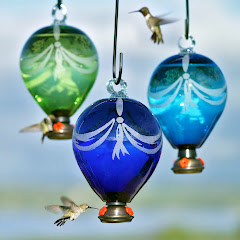Tuesday, May 27, 2008
Hummingbird Nectar Recipe
Hummingbird nectar is not as difficult as a lot of companies make it out to be. When it comes to buying hummingbird nectar don't believe the hype! You don't have to have "extra protein" or "electrolytes" or "flavors" in your nectar - those are gimmicks that waste your time and money! Hummingbird nectar is really a simple sugar solution, and the best way to make it at home is with your own table sugar.
Nectar Recipe: 4 parts water to 1 part sugar.
Table sugar is the closest thing to the nectar found in hummingbirds' favorite flowers, and you'll get the best results from using our simple nectar recipe. FDA approved, your table sugar doesn't have any extra coloring, additives, or preservatives and if it's good enough for people you can be sure it'll be good enough for your hummingbirds! Although you can use any type of sugar, plain white granulated sugar (cane or beet) works the best. Raw sugar you may have problems with dissolving all the sugar and brown sugars contain molasses that will increase bacterial growth. Plain tap water is okay for your nectar, but if you live in an area where you use well water you will need to boil the water before adding the sugar! Trace amounts of fluoride, chlorine, or other tap minerals won't hurt your hummingbirds, but if concerned filter the water ahead of time.
Please remember: experts DO NOT recommend adding any food coloring to your nectar!!! Hummingbirds feed from all colors of flowers, not just red flowers. They go to nectar sources that give them the most bang for their buck - and if a white flower has better nectar than a red flower they'll go to the white instead. Bright colors do attract hummingbirds, but the red food coloring people add to their feeders can build up in the hummer's liver and be harmful. If you want to add the color red to get hummingbirds to your feeder, use a red ribbon by the hook or something like a red shade or ant-moat. Never-ever use red food coloring!
Other tips to keep your hummingbirds happy are:
Change your hummingbird nectar regularly (3-5 days in cool weather, 1-2 days in hot weather). The fresher your nectar the more hummingbirds will seek it out. Old nectar can grow bacteria or ferment (becoming alcohol) and your birds will stop feeding from it.
Make batches of nectar and keep excess stored in your refrigerator for up to two weeks. This'll save you time and energy in mixing up the nectar, and you'll have plenty on hand to refill feeders frequently. High volume areas you may go through a gallon of nectar in a few days!
Sweeten the deal If your hummingbirds are getting lured from your feeders, get them back by upping the ante and sweetening your nectar. Hummingbirds like a good deal as much as anyone, and a change to 3 part water to 1 part sugar recipe will get them back to using your feeders as their main meal.
Bees will scare hummingbirds away so if you have uninvited guests at your feeder you need to systematically move it. Bees send out scouts to find nectar, and once the hive knows your location you'll need to keep changing addresses to lose them. Move your feeder at least 3 feet everyday, and the bee scouts will lose the whereabouts. Luckily, your hummingbirds have amazing memory and will still know your feeder's vicinity (the smart little things)!
Subscribe to:
Post Comments (Atom)

Hummingbird in Napa, CA



No comments:
Post a Comment